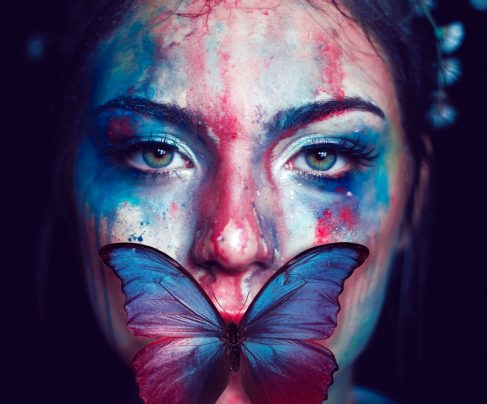
Meet the Director Street Heroines’ Alexandra Henry
The term street art typically conjures up images of gang Signs, rebellious teens, and men. But did you know, not only are street artist becoming more respected–a year ago, infamous street artist Banksy sold a bit for $1.4 million–but women street artists are getting the respect they’re due. Since the street art flourish in the 1970s, women like Lady Pink, Charmin 65, JDL Street Art, Negahamburguer, Kashink, Tatyana Fazlalizadeh, Shamsia Hassani and many more have been covering parks, walls, and buildings with their particular creative swagger.
In a new documentary, director Alexandra Henry journeys the World interviewing these musicians. In Street Heroines, she and her crew (Zahra Sherzad, Jordan Noël Hawkes, Diana Eliazov, Simone Cassas) record the courage and creativity of feminine graffiti and street artists in Nyc, Brooklyn, Mexico City, Chile, Ecuador, Brazil, Puerto Rico, Japan, Spain, and France.
We had the opportunity to catch up with Alexandra Henry and find out more about the girls who are taking street art to another level.
What prompted you to make Street Heroines?
I had been inspired to make a documentary that gave Underrepresented girls a voice. I had my’ah-ha’ moment when I saw two women painting at 5Pointz in Queens back in 2012. We had a brief chat, I took their photographs and we exchanged contacts to keep the dialogue going. I immediately realized how little I understood about girls in the road art/graffiti culture. When I did some of my own digging on the internet to see what else was happening with all the women’s involvement, I found very little. So, I chose to help tell their stories, write them in the history of one of the largest art moves now.
What was the most challenging part of making the movie?
This was a passion project, continuing now for seven Decades And is the first feature-length movie I have led. It is difficult to keep up the steam on separate projects that have little to no funding, and, at the same time, have a fulltime job which pays the bills. I’ve realized that if I do not put energy into this job daily, nobody else will. Another challenge for me personally has been writing the script, which in documentary filmmaking a great deal of times comes after you’ve taken everything. There are so many strong statements from the over fifty women I have interviewed, so it is difficult to choose.
Cropped picture of manager Alexandra Henry
Alexandra Henry. Photo from Ethan Scarduzio.
What was the most interesting part of making the film?
The most fun Component of the filmmaking process is linking With people, with all the artists, with the movie crew, as well as the communities we all get to meet on the way. This job has taken me to about eleven countries, sometimes alone to shoot and other times with a little crew whenever there are not funds. Street Heroines is now my ultimate excuse to selfishly traveling the world while at exactly the same time fueling the societal causes of girls on a worldwide level. There is a balance there and I feel really thankful to have deepened my own human experience in addition to that of others.
Do you have a favourite street art style?
I like personality driven graffiti, especially Illegal walls, that involve more risk. I appreciate clever messaging too, whether through words or images. In the movie you hear about the’pixação’ style in Sao Paulo, that is native to the city and how without’pixo’ Sao Paulo would not be Sao Paulo. That is what graffiti is for me personally, the expression or language of a city, that if you can’t see it, you still know that”wow something is happening here.”
We want to keep Street Heroines moving as a docuseries and Are searching for manufacturing partners to make a reality. I work from the branded content space for a manufacturer and feel as there are chances to turn Street Heroines in an immersive documentary encounter, via a six-part episodic series, travel to Africa, Europe, and Asia. Additionally, we’ve invented an educational effect strategy to educate young girls on the company and creativity of being an artist. It can be integrated into artwork institution programming, such as at SAAM, for example, as well as high school program. And personally, I want to guide more, perhaps a short narrative next.
Everybody would like to be viewed. In the movie, Fusca, from Mexico, said it best. “I love to challenge the conceptions and go beyond the concepts of what it means for a girl.” Street Heroines gives voice to women fighting social injustice with ingenuity in a male-dominated subculture.
University Documentary Center Director Nina Gilden Seavey, immediately follows.
The term street art typically conjures up images of gang Signs, rebellious teens, and men. But did you know, not only are street artist becoming more respected–a year ago, infamous street artist Banksy sold a bit for $1.4 million–but women street artists are getting the respect they’re due. Since the street art flourish in the 1970s, women like Lady Pink, Charmin 65, JDL Street Art, Negahamburguer, Kashink, Tatyana Fazlalizadeh, Shamsia Hassani and many more have been covering parks, walls, and buildings with their particular creative swagger.
In a new documentary, director Alexandra Henry journeys the World interviewing these musicians. In Street Heroines, she and her crew (Zahra Sherzad, Jordan Noël Hawkes, Diana Eliazov, Simone Cassas) record the courage and creativity of feminine graffiti and street artists in Nyc, Brooklyn, Mexico City, Chile, Ecuador, Brazil, Puerto Rico, Japan, Spain, and France.
We had the opportunity to catch up with Alexandra Henry and find out more about the girls who are taking street art to another level.
What prompted you to make Street Heroines?
I had been inspired to make a documentary that gave Underrepresented girls a voice. I had my’ah-ha’ moment when I saw two women painting at 5Pointz in Queens back in 2012. We had a brief chat, I took their photographs and we exchanged contacts to keep the dialogue going. I immediately realized how little I understood about girls in the road art/graffiti culture. When I did some of my own digging on the internet to see what else was happening with all the women’s involvement, I found very little. So, I chose to help tell their stories, write them in the history of one of the largest art moves now.
What was the most challenging part of making the movie?
This was a passion project, continuing now for seven Decades And is the first feature-length movie I have led. It is difficult to keep up the steam on separate projects that have little to no funding, and, at the same time, have a fulltime job which pays the bills. I’ve realized that if I do not put energy into this job daily, nobody else will. Another challenge for me personally has been writing the script, which in documentary filmmaking a great deal of times comes after you’ve taken everything. There are so many strong statements from the over fifty women I have interviewed, so it is difficult to choose.
Cropped picture of manager Alexandra Henry
Alexandra Henry. Photo from Ethan Scarduzio.
What was the most interesting part of making the film?
The most fun Component of the filmmaking process is linking With people, with all the artists, with the movie crew, as well as the communities we all get to meet on the way. This job has taken me to about eleven countries, sometimes alone to shoot and other times with a little crew whenever there are not funds. Street Heroines is now my ultimate excuse to selfishly traveling the world while at exactly the same time fueling the societal causes of girls on a worldwide level. There is a balance there and I feel really thankful to have deepened my own human experience in addition to that of others.
Do you have a favourite street art style?
I like personality driven graffiti, especially Illegal walls, that involve more risk. I appreciate clever messaging too, whether through words or images. In the movie you hear about the’pixação’ style in Sao Paulo, that is native to the city and how without’pixo’ Sao Paulo would not be Sao Paulo. That is what graffiti is for me personally, the expression or language of a city, that if you can’t see it, you still know that”wow something is happening here.”
We want to keep Street Heroines moving as a docuseries and Are searching for manufacturing partners to make a reality. I work from the branded content space for a manufacturer and feel as there are chances to turn Street Heroines in an immersive documentary encounter, via a six-part episodic series, travel to Africa, Europe, and Asia. Additionally, we’ve invented an educational effect strategy to educate young girls on the company and creativity of being an artist. It can be integrated into artwork institution programming, such as at SAAM, for example, as well as high school program. And personally, I want to guide more, perhaps a short narrative next.
Everybody would like to be viewed. In the movie, Fusca, from Mexico, said it best. “I love to challenge the conceptions and go beyond the concepts of what it means for a girl.” Street Heroines gives voice to women fighting social injustice with ingenuity in a male-dominated subculture.
University Documentary Center Director Nina Gilden Seavey, immediately follows.



